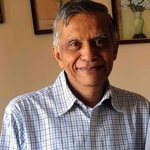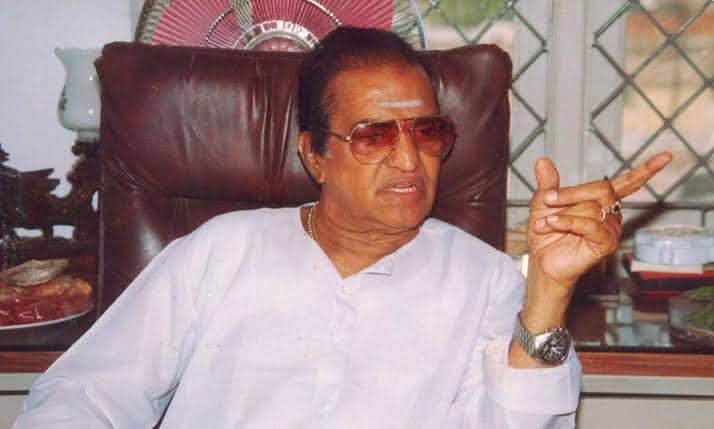
Nandamuri Taraka Rama Rao, whose birth anniversary is celebrated on May 28, straddled two worlds–cinema and politics–like an overlord. He strode on the cinema stage like a colossus and was willingly added to their pantheon of gods by the cine-goers. In politics too, he was the monarch of all he surveyed while the going was good.
What prompted the hero of 300 films to embrace politics? After achieving name and fame, people set their sight on power. NTR could not have been an exception. He watched former room-mate and old friend Bhavanam Venkatram take oath as the Chief Minister at the ornate Durbar Hall of the Raj Bhavan in February 1982. The pomp and ceremony attending the function may have kindled in him desire for the coveted post. T Anjaiah, a senior politician, once said had the Congress offered NTR a seat in the Legislative Council it would have been spared the humiliating defeat in the 1983 elections. These theories may at best be conjectures.
Rama Rao had a miraculous escape from a life-threatening accident during a shooting (likely ‘Simham Navvindi’). He turned introspective and was convinced that God had marked him for a bigger role than acting. It was this incident which, many believe, motivated him to enter politics and serve the people.
He lost no time in forming the Telugu Desam party and hitting the road. His slogan: Samajame devalayam, prajale naa devullu caught the imagination of the masses.
What unfolded in the weeks and months to come boggled the imagination alike of the people, the media and most of all, politicians.
He dusted up his vintage Chevrolet van and converted it into a ratham, fitted with rotating floodlights and loudspeakers. The Chaitanya Ratham, had ample space for NTR and others and a hatch through which he climbed to the top to address gatherings.
Dressed in bell-bottom khaki trousers and a full-sleeved shirt, NTR would ride atop the ratham through the countryside, logging over 100 km every day, stopping to address a small gathering, which would soon snowball into a big one, or waving to men and women working in the fields. For months, the Chaitanya Ratham was his home away from home. He ate, slept and worked in it. Elder son, Harikrishna was at the wheel for most part.
He would stop by the roadside for a quick bath, interact with villagers and truck drivers at a kaka hotel and share oven-fresh idli, pesarattu-upma and coffee etc. These activities constituted regular menu that the Telugu newspapers dished out for their readers.
People waited for hours to catch a glimpse of their screen god in new avatar. The party’s signature tune, Maa Telugu thalliki malle poodanda, heralded the arrival of the ratham with an electrifying effect. The response would invariably be overwhelming. He would be late by 24 hours, sometimes even longer. But people would wait regardless. They would camp right on the roadside, bringing along cots, stoves and utensils just to make sure they did not miss him. Women would stop the ratham to offer harathi.
Two aspects of NTR’s style of establishing rapport with the people stood out for their hypnotic appeal. Not for him the worn-out sodara, sodarimanulaara. He stirred the heart-strings of the audience with ‘naa Tenuginti aadapaduchalaara, thammullaara.’ No politician had done this before. In the good old days, the Congress party depended for votes on a handful of trusted and powerful men whose writ ran in the villages. Then, its leaders addressed meetings in select cities and towns and communicated with a limited number of voters. In contrast, rath yatra enabled Rama Rao to have direct contact with tens of thousands of people across the State.
‘Madama thippadam maa vamsamlo ledu’ (beating a retreat is not in our grain) is a common refrain in films starring Balakrishna or other Nandamuri scions. This was never more in evidence than during NTR’s first campaign in 1982. Beginning the tour sometime in April, he did not return to Hyderabad until the elections were announced many months later. During the tour, he vomited blood and was advised by doctors to suspend the campaign. Close aides suggested he return home, as nothing could stop a landslide victory. No, he continued regardless. Yes. Beating a retreat was not in his grain. He had missed even marriage of two of his sons. That was his unwavering focus.
Rivals ridiculed NTR’s road shows as yet another celluloid fad which would at best amuse and entertain, but never pay in terms of votes. Soon it became clear to them that it was no laughing matter. Following the dictum ‘if you cannot kick your opponent, join him’, they have whole heartedly embraced NTR brand of road shows.
None can match Nandamuri Taraka Rama Rao’s game-changing campaign style for its novelty, colour, reach and above all response.
He chose to take oath as the Chief Minister not at the Raj Bhavan but in the presence of ‘naa prajalu’ at the Lal Bahadur stadium on January 9, 1983. Another out of the box idea put in practice.
Dasu Kesava Rao is a seasoned journalist who has worked, among several newspapers, with The Hindu and served as its Bureau Chief in Hyderabad.

